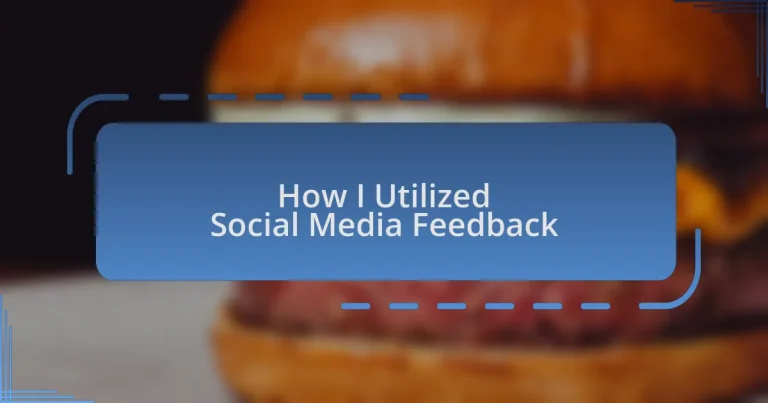Key takeaways:
- Social media feedback is essential for businesses, providing insights that help improve products and foster customer trust.
- Engaging with customers through polls, direct responses, and virtual events creates a sense of community and encourages valuable suggestions.
- Analyzing feedback allows businesses to identify trends and emotional connections, leading to meaningful improvements and customer loyalty.
- Implementing changes based on feedback, such as expanding menus or improving service, enhances customer satisfaction and operational efficiency.
Author: Olivia Hartwell
Bio: Olivia Hartwell is a contemporary fiction author known for her compelling narratives and vivid characterizations. With a background in literature and creative writing, she has a keen eye for detail and a passion for exploring the complexities of human relationships. Olivia’s debut novel, Whispers of the Heart, received critical acclaim and was nominated for several literary awards. When she’s not writing, she enjoys hiking in the mountains of Colorado and sipping artisanal coffee at local cafes. Olivia resides in Denver with her beloved rescue dog, Rosie.
Understanding social media feedback
Social media feedback can be both a treasure trove and a challenging maze. I remember when I first started my gourmet burger truck; I was overwhelmed by the comments and reviews pouring in. Have you ever wondered how a single tweet or Instagram post can sway the opinions of hundreds? That initial rush of engagement felt exhilarating yet daunting, as it highlighted the power of connection and opinion in shaping my business.
I’ve learned that not all feedback is constructive, but it’s crucial to sift through the noise. For instance, I once received a harsh critique on my onion rings being too greasy. Initially, it stung, but I realized it was an opportunity for improvement. How do we differentiate between mere complaints and genuine suggestions? I began to see these critiques not just as criticism but as a chance to connect with my customers by showing them that I value their opinions.
Understanding social media feedback requires emotional intelligence and a willingness to adapt. I vividly recall a customer who shared a heartfelt story about how my burgers reminded them of family gatherings. That kind of feedback, filled with personal anecdotes, reminds me that we’re not just selling food; we’re creating experiences and memories. Have you noticed how some voices resonate more than others? It’s these emotional connections that truly matter, shaping both the brand and the community around it.
Importance of feedback for businesses
Gathering feedback is essential for businesses, as it provides a direct line to what customers think and feel about their offerings. I recall a time when I impulsively decided to try a new burger recipe, and the mixed reviews were instrumental in shaping my menu. Just like a cup of coffee that you can’t quite get right, the flavor of your business is ultimately dependent on customer perceptions and reactions.
While not every piece of feedback will hit home, it offers invaluable insights into areas needing improvement. For example, I once received a comment about a new sauce being overly spicy—something I hadn’t anticipated. That feedback prompted me to reconsider my flavor profiles and incorporate customer preferences. Isn’t it fascinating how a single piece of advice can lead to a better product and happier customers?
Taking feedback to heart fosters a culture of transparency and trust. I remember personally responding to a customer who felt my truck lacked vegetarian options. This conversation blossomed into brainstorming sessions that led to a delicious veggie burger. Have you ever experienced a change in service or product because you voiced your opinion? Engaging in this way not only enhances the customer experience but also empowers them, creating a loyal community around your brand.
Utilizing feedback for improvement
When I first started considering social media feedback, it felt like opening Pandora’s box. I was surprised at how candidly people expressed their preferences. For instance, an enthusiastic customer posted about craving a spicier burger, and that inspired me to test a new spicy variant. Listening to that voice, I realized how much potential exists in the ideas shared by customers—like discovering hidden gems within a treasure chest.
I also learned that organized feedback helps pinpoint specific areas to enhance. One evening, after noticing a dip in our late-night sales, I asked followers what they wanted for dinner at that hour. The responses were eye-opening, leading me to rethink our late-night menu entirely. By incorporating more comfort foods, I saw an immediate uptick in sales. It’s interesting how just a few thoughtful questions can lead to significant shifts in business performance.
Using social media as a feedback platform has transformed the way I approach improvements. In one instance, a patron mentioned they loved our burgers but struggled to get them delivered. That comment sparked a collaboration with delivery services, ultimately expanding our reach. I can’t help but wonder: how many success stories are hidden in the feedback we receive? Embracing customer insights not only drives business growth but also creates stronger connections with diners—who wouldn’t want that?
Strategies for collecting feedback
To collect valuable feedback, I found that creating engaging polls on social media can be incredibly effective. For example, I recently asked my followers to choose their favorite burger toppings, which led to lively discussions and even prompted some unique topping suggestions. This interaction not only provided insights into customer preferences but also sparked excitement around our offerings.
Another strategy I employed was actively responding to comments and messages to foster a sense of community. I remember one customer who reached out with a suggestion for a vegan burger option. By engaging with them and showcasing my willingness to bring their idea to life, I made them feel valued. It’s amazing how a simple acknowledgment can turn a casual follower into a devoted fan.
Lastly, I began hosting occasional virtual tasting events where customers can provide real-time feedback on new items. One evening, as I shared our latest gourmet creations, I encouraged participants to share their thoughts freely. The immediate responses helped me tweak flavors on the spot, creating a collaborative environment that I believe customers genuinely appreciate. How much more could businesses learn if they encouraged this level of interaction?
Analyzing feedback for insights
Delving into the feedback I gathered, I was often surprised by the layers of insight it provided. For instance, I noticed a recurring theme where customers expressed a desire for innovative sauces. I took this feedback to heart; it felt like an invitation to experiment and elevate our menu. Have you ever felt that spark of creativity when someone appreciates your potential? It’s a rewarding experience that can reshape your offerings.
While sifting through comments, I found that some critiques were more valuable than compliments. One particularly constructive comment about portion sizes pulled at me. Instead of taking it personally, I recognized it as an opportunity for growth. I rolled up my sleeves and adjusted the menu accordingly. That simple change not only satisfied our customers but also built a stronger bond of trust. Did I ever expect that a single observation could lead to such positive changes? Absolutely not, but it taught me a vital lesson about being responsive.
During my analysis process, I also realized how emotional connections play a significant role in feedback. One customer shared a heartfelt story about how they celebrated a milestone with our burgers, which moved me deeply. Their experience highlighted the impact of our food beyond just taste; it became a part of their cherished memories. How profound is it, knowing that our creations contribute to joyful moments? This insight pushes me to not just serve food, but to create experiences that resonate with people on a personal level.
Implementing changes based on feedback
Taking action on customer feedback has been a transformative journey for my gourmet burger truck. For example, after receiving several mentions about our side options being limited, I decided to introduce a rotating seasonal side menu. This wasn’t just about adding variety; it was an opportunity to showcase local ingredients. Have you ever experienced the excitement of aligning your offerings with what your customers truly crave? It’s exhilarating.
When I implemented a new sauce line based on suggestions, I felt a mix of anticipation and nerves. The process wasn’t instantaneous; we had numerous tastings and feedback sessions to hit the right flavors. But when our customers started sharing their enthusiasm online, it was a defining moment for my team and me. There’s something undeniably fulfilling in knowing that you’ve connected and resonated with your patrons, isn’t there?
Moreover, I’ve learned to embrace the less glamorous aspects of feedback. A frustrated customer pointed out that our wait times had increased during peak hours. Initially, it stung, but this prompted an honest evaluation of our operations. By tweaking our workflow and staffing, we significantly improved service, which not only pleased our patrons but also reduced stress for our team. Isn’t it amazing how constructive criticism can turn into a pathway for enhancement? Responding to feedback has become less about defensiveness and more about partnership with my customers.


